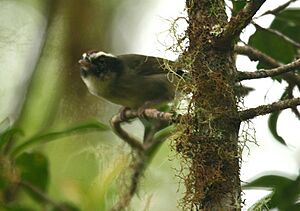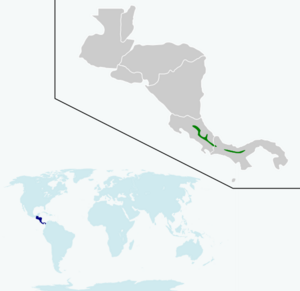Black-cheeked warbler facts for kids
Quick facts for kids Black-cheeked warbler |
|
|---|---|
 |
|
| Conservation status | |
| Scientific classification | |
| Genus: |
Basileuterus
|
| Species: |
melanogenys
|
 |
|
| Range of B. melanogenys | |
The black-cheeked warbler (Basileuterus melanogenys) is a small, colorful New World warbler. These birds live all year round in the Talamancan montane forests. You can find them in Costa Rica and the western part of Panama.
Contents
Where Do Black-Cheeked Warblers Live?
These warblers usually live in oak forests. They like places with lots of thick bamboo plants growing underneath the trees. They prefer high places, from about 2,500 meters (8,200 feet) up to the tree line. Sometimes, they can be found a bit lower, around 1,600 meters (5,250 feet).
Nesting and Young Birds
When it's time to have babies, a pair of black-cheeked warblers builds a large, round nest. It looks like a dome with an opening on the side. They often build these nests on a sloped bank or inside a small ditch. The female warbler will lay two white eggs.
What Do Black-Cheeked Warblers Look Like?
The black-cheeked warbler is a small bird, about 13 to 13.5 centimeters (5 inches) long. It weighs around 13 grams (less than half an ounce).
Special Features
This bird has a reddish-brown top of its head, called a rufous crown. It has long white stripes above its eyes, which are called supercilia. Its most noticeable feature is its black cheeks! The top part of its body is a dull olive green. Its chest is olive-grey, and its belly is yellowish-white.
Males, Females, and Young Birds
Male and female black-cheeked warblers look very much alike. Young birds, however, are a bit different. Their upper parts are browner, and their white eye stripes are not as bright. Their chest is also greyer, and they have two cinnamon-colored stripes on their wings.
What Do Black-Cheeked Warblers Eat?
Black-cheeked warblers mostly eat insects. They also enjoy spiders and other small invertebrates. They find their food low down in the undergrowth, among the plants.
What Do Black-Cheeked Warblers Sound Like?
The call of the black-cheeked warbler is a sharp, hard sound, like "tsit." The male bird's song is a soft, spluttering sound. It sounds like "tsi tsi wee tsi tsi wu tsi wee."


